Regarding the low-frequency standing wave model analysis of the small room, John Dahl, director of THX training, pointed out in the December 2008 THX Home Theater II training class that the acoustic processing of small home theaters is mainly divided into three frequency bands: <200Hz, 200Hz-2kHz, > 2kHz.
In the high frequency range above 2 kHz, the indoor sound quality is mainly determined by the speaker itself, and the influence of the room itself on the sound quality of the high frequency band is not great. The performance of the tweeter, the quality of the crossover and the design of the cabinet largely determine the performance of the high frequencies. Simple sound absorption and diffusion processing in the room can achieve better results without the need for particularly complicated design and processing (of course, professional acoustic design processing can make the sound quality more assured). This is why many dealers' audio-visual rooms and enthusiasts do not do professional acoustic processing at home, but the high-band tone performance is also very good. The speaker is good, and the high frequency performance is natural.
At the end of 2008, the Guangzhou White Swan Sound Exhibition had several floors. The Hi-Fi merchants at the exhibition rented the hotel's small room to showcase their products. The room size was very small and did not do any acoustic treatment, but the live demonstration The high frequency effect is basically good.
In the mid-low frequency range of 200Hz-2kHz, the indoor sound quality is determined by the room and the horn. In this band, the room gradually begins to affect the sound quality, and controlling the Sound Boundary Interference Response is very important. Choose a high-quality speaker with a flat frequency response and position it correctly. Place the right sound-absorbing and diffusing material in the right position to ensure accurate mid-low frequency effects. Professional acoustic designers can find the right position and associated acoustic parameters through software analysis.
Speaking of this, we can understand that the frequency band above 200Hz can achieve better results by placing the speakers and using acoustic treatment materials in the room. Therefore, enthusiasts who are mainly vocal or light music appreciation can consult professional acoustic designers to purchase appropriate acoustic processing materials to improve sound quality. China Home Theater Network
In the low frequency range below 200Hz, the sound quality is basically determined by the room. The ultra-bass of 70,000 yuan and the subwoofer of 20,000 yuan are not much different in terms of sound quality. In this frequency range, the low frequency standing wave of the small room determines the overall tone of the low frequency. Only by reducing the influence of the low frequency standing wave can the low frequency effect be improved. Therefore, if you spend 50,000 yuan to buy a high-burning subwoofer, you might as well buy a 20,000-ton super bass and spend some money to hire a professional home acoustic designer to analyze, test and purchase low-frequency processing props ( EQ, low frequency sound absorber) come true.
Many enthusiasts think that replacing a "good" subwoofer can significantly improve low-frequency sound quality. Unfortunately, the room's low-frequency standing wave is not well handled, and a one-million-dollar subwoofer can't improve the low-frequency sound quality. In fact, replacing a subwoofer of 1 million yuan may make the sound more difficult to listen to. (After the larger diameter of the unit, the output is stronger, which may cause the low frequency standing wave phenomenon to be more obvious).
There are five ways to reduce the effects of low frequency standing waves:
Change the size of the room
2. Change the position of the subwoofer
3. Change the position of the sofa
4. Use low frequency sound absorbing materials
5. Using the equalizer (EQ)
In the case that the room layout has been fixed and the decoration has been completed, the combination of the second, third and fifth means can still improve the low-frequency sound quality by 15%-25% (depending on the actual situation of the room). If you start the acoustic design plan before the renovation, the final result will be very ideal. The following is an example analysis to show the analysis process of the low frequency standing wave in the small room.
The professional software for this demonstration was provided by Gerry Lemay, Technical Director of the American HAA Association, and I would like to express my gratitude to the American HAA Association and Mr. Lemay.
The choice of room size is the most critical part of the low-frequency standing wave analysis of the small room. A reasonable ratio can greatly reduce the influence of the low-frequency standing wave, and it also makes the later debugging easier.
After starting the home theater professional design software, enter the low frequency standing wave analysis module, the interface is as follows:
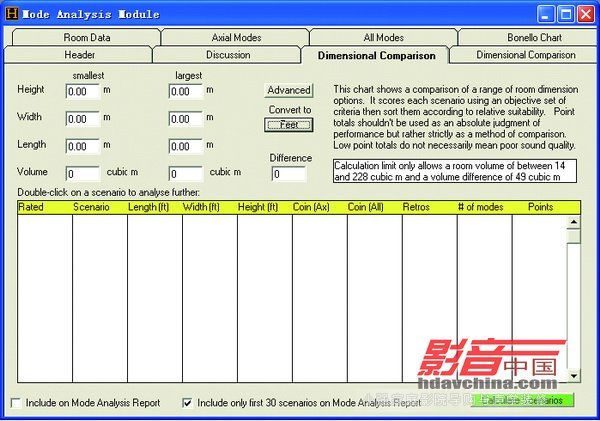
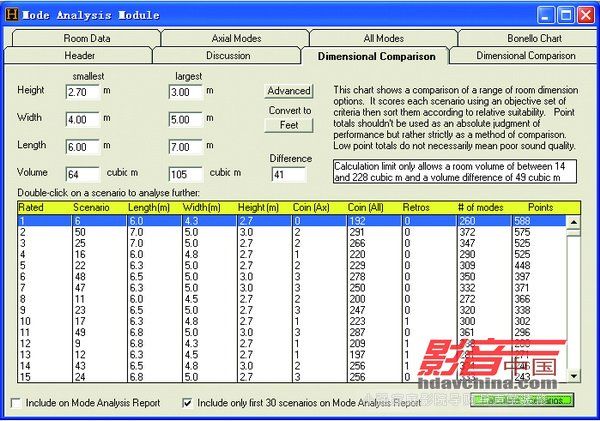
We enter the minimum allowable value and the maximum allowable value of each side of the room into the corresponding space on the upper left side, click on the automatic calculation in the lower right corner, and the order of the room size is generated. In this case, the best recommended size given by the software is 6m long, 4.3m wide, and 2.7m high (blue part). The column “Coin(Ax)†shows the number of coincidences of the axial standing waves. As you can see, the number of coincidences is actually 0, which is quite ideal. China Home Theater Network
The software automatically sorts the room sizes in order, which is convenient for the engineering designer to choose according to the actual situation on site. From the above figure, we can see that the second-sized room size is 7m long, 5m wide, 3m high, and the number of axial standing wave coincidences is 2, but whether the two standing wave coincidences occur in the first four harmonics range. Inside? If there is a higher harmonic, then the impact is not great. Moreover, this size can make the room size and volume larger, and customers will definitely prefer this size. Let's take a look at the list of axial standing waves.
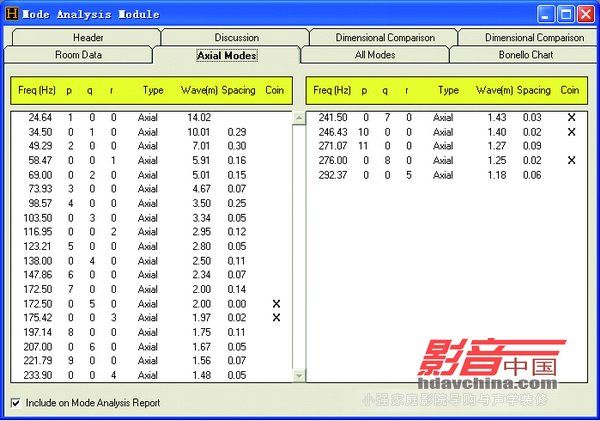
From the above figure we can see that there are only two overlaps below 200H. The first overlap - the 7th harmonic of the 7th harmonic of the axial length of the room overlaps with the 5th harmonic of the width of the width of 172.5Hz; they are all higher harmonics, and the resonance intensity is not too strong; The second overlap - the third harmonic of the room width axial 175.42 Hz and the previous 172.5 Hz degenerate (with a frequency difference of less than 5%), the solution to the problem can be the use of plate resonance sound absorber or other technical means, the difficulty Not too big. Therefore, the second room size is also a very good choice.
Next, we continue to analyze the position of the subwoofer and the position of the seat in 7m long, 5m wide, and 3m high, in order to obtain a flat low frequency response curve at all positions in the room.
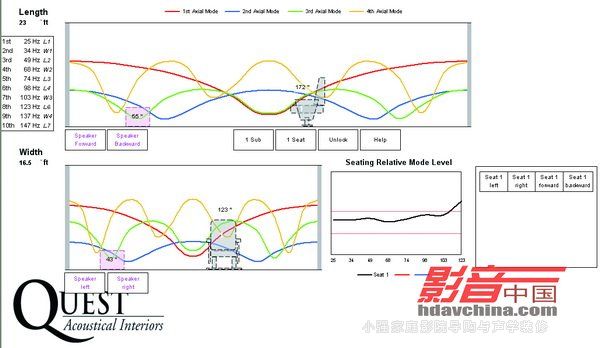
The analysis results came out:
The best position for the subwoofer: 139cm from the front wall (20% of the total length of the room), 95cm from the side wall (left or right) (19% of the room width).
Best seat position (1 position): 436cm from the front wall and 188cm from the side wall (left or right).
You can see that the frequency response curve is still very flat (the black curve in the lower right corner of the figure).
Home theaters usually have multiple seats, and we add 3 more seats. Perform the same analysis in sequence.
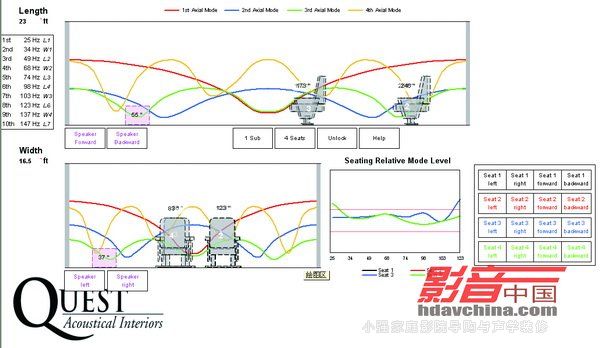
The graph shows that the frequency response curves of the two positions (2 and 4) in the back row are not ideal (blue and green curves in the lower right corner of the figure), but the fine adjustment by the late EQ should achieve better results. .
The final floor plan is as follows. At this step, the position of the subwoofer and the position of the seat are basically determined, and we can deepen the design later. This example only analyzes the design of a single subwoofer. If you use 2 or even 4 subwoofers, the analysis process will become more complicated.
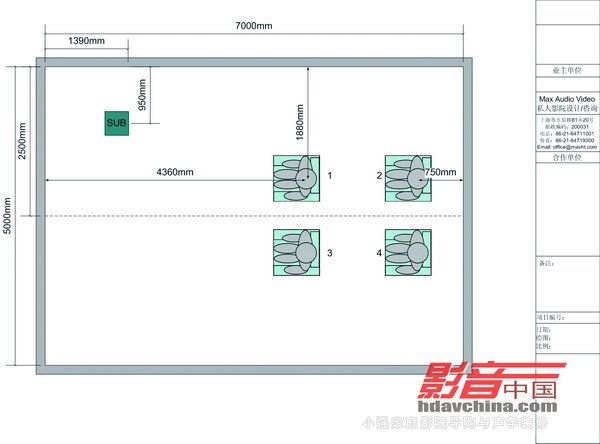
Electronic motors specilized for Shangri-la blinds.
Constant Speed Shangri-La Blinds Motors,15Mm Dc Shangri-La Blinds Motors,Mechanical Limits Shangri-La Blinds Motors,Electronic Limit Shangri-La Blinds Motors
GUANGDONG A-OK TECHNOLOGY GRAND DEVELOPMENT CO.,LTD. , https://www.a-okmotor.com
